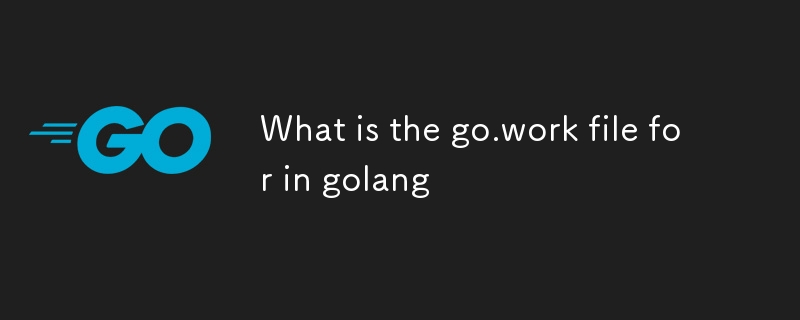The go.work file is a multi-module workspace configuration file introduced in Go 1.18 to merge multiple local modules in development. 1. It allows direct reference to multiple local modules in a workspace to avoid frequent switching or downloading remote dependencies; 2. Creation methods include command go work init or manually writing configuration files for specifying module paths; 3. Typical uses include local debugging of multiple modules, sharing code across projects, and simplifying the CI/CD process; 4. When using it, please note that it is only valid for the current workspace and does not replace the go.mod and vendor directories, and it is recommended to be used only in the development test stage.

The Go workspace file (go.work) is a new feature introduced in Go 1.18 to support multi-module workspaces. It allows developers to use multiple Go modules simultaneously in a working directory without frequent switching or reconfiguring the environment.

What is a go.work file?
Simply put, the go.work file is a configuration file used to define a "workspace". When you are developing multiple interrelated modules, such as a main project relies on several submodules in local development, you can organize them with go.work . The advantage of this is that you can directly reference the local code instead of downloading the remote module every time.

How to create a go.work file?
To generate a go.work file, run in the parent directory containing multiple module roots:
go work init ./module1 ./module2 ...
Or create it manually, the content is roughly as follows:

go 1.18
use (
./my-main-module
./my-shared-library
)This configuration tells the Go toolchain to use modules under these local paths first when building and testing, rather than downloading them in GOPROXY.
Typical uses of go.work
- Debugging multiple modules locally : for example, you are developing a main service module and a public library module, both of which are being developed locally.
- Share code across projects : If you have multiple projects that depend on the same internal library, you can point directly to the local version.
- Simplify the multi-warehouse collaboration process : Quickly replace certain modules to local versions for testing in CI/CD or team collaboration.
For example: You have two projects:
-
projectAis your main application -
sharedLibis a library you wrote yourself and is under development
You want to test whether the latest changes to sharedLib affect projectA, and you can use go.work to connect them together.
What should I pay attention to when using go.work?
- It only works in the current workspace and does not affect other projects.
- If you execute
go mod tidy, it will not modify the content in go.work. - It is not a replacement for
go.mod, but a supplement to multi-module management.
Some common misunderstandings:
- ? I think go.work can replace the vendor directory
- ? Misuse of go.work in production environment leads to dependency confusion
Therefore, it is recommended to use it only during the development and testing phases, and make sure that all dependencies are correctly pointed to the remote version before going online.
Basically that's it. Rational use of go.work can greatly improve the development efficiency of multi-module projects, but you should also be careful not to let it interfere with normal dependency management.
The above is the detailed content of What is the go.work file for in golang. For more information, please follow other related articles on the PHP Chinese website!

Hot AI Tools

Undress AI Tool
Undress images for free

Undresser.AI Undress
AI-powered app for creating realistic nude photos

AI Clothes Remover
Online AI tool for removing clothes from photos.

Clothoff.io
AI clothes remover

Video Face Swap
Swap faces in any video effortlessly with our completely free AI face swap tool!

Hot Article

Hot Tools

Notepad++7.3.1
Easy-to-use and free code editor

SublimeText3 Chinese version
Chinese version, very easy to use

Zend Studio 13.0.1
Powerful PHP integrated development environment

Dreamweaver CS6
Visual web development tools

SublimeText3 Mac version
God-level code editing software (SublimeText3)

Hot Topics
 What are the implications of Go's static linking by default?
Jun 19, 2025 am 01:08 AM
What are the implications of Go's static linking by default?
Jun 19, 2025 am 01:08 AM
Go compiles the program into a standalone binary by default, the main reason is static linking. 1. Simpler deployment: no additional installation of dependency libraries, can be run directly across Linux distributions; 2. Larger binary size: Including all dependencies causes file size to increase, but can be optimized through building flags or compression tools; 3. Higher predictability and security: avoid risks brought about by changes in external library versions and enhance stability; 4. Limited operation flexibility: cannot hot update of shared libraries, and recompile and deployment are required to fix dependency vulnerabilities. These features make Go suitable for CLI tools, microservices and other scenarios, but trade-offs are needed in environments where storage is restricted or relies on centralized management.
 How does Go ensure memory safety without manual memory management like in C?
Jun 19, 2025 am 01:11 AM
How does Go ensure memory safety without manual memory management like in C?
Jun 19, 2025 am 01:11 AM
Goensuresmemorysafetywithoutmanualmanagementthroughautomaticgarbagecollection,nopointerarithmetic,safeconcurrency,andruntimechecks.First,Go’sgarbagecollectorautomaticallyreclaimsunusedmemory,preventingleaksanddanglingpointers.Second,itdisallowspointe
 How do I create a buffered channel in Go? (e.g., make(chan int, 10))
Jun 20, 2025 am 01:07 AM
How do I create a buffered channel in Go? (e.g., make(chan int, 10))
Jun 20, 2025 am 01:07 AM
To create a buffer channel in Go, just specify the capacity parameters in the make function. The buffer channel allows the sending operation to temporarily store data when there is no receiver, as long as the specified capacity is not exceeded. For example, ch:=make(chanint,10) creates a buffer channel that can store up to 10 integer values; unlike unbuffered channels, data will not be blocked immediately when sending, but the data will be temporarily stored in the buffer until it is taken away by the receiver; when using it, please note: 1. The capacity setting should be reasonable to avoid memory waste or frequent blocking; 2. The buffer needs to prevent memory problems from being accumulated indefinitely in the buffer; 3. The signal can be passed by the chanstruct{} type to save resources; common scenarios include controlling the number of concurrency, producer-consumer models and differentiation
 How can you use Go for system programming tasks?
Jun 19, 2025 am 01:10 AM
How can you use Go for system programming tasks?
Jun 19, 2025 am 01:10 AM
Go is ideal for system programming because it combines the performance of compiled languages ??such as C with the ease of use and security of modern languages. 1. In terms of file and directory operations, Go's os package supports creation, deletion, renaming and checking whether files and directories exist. Use os.ReadFile to read the entire file in one line of code, which is suitable for writing backup scripts or log processing tools; 2. In terms of process management, the exec.Command function of the os/exec package can execute external commands, capture output, set environment variables, redirect input and output flows, and control process life cycles, which are suitable for automation tools and deployment scripts; 3. In terms of network and concurrency, the net package supports TCP/UDP programming, DNS query and original sets.
 What are functional options patterns in Go, and when are they useful for constructor design?
Jun 14, 2025 am 12:21 AM
What are functional options patterns in Go, and when are they useful for constructor design?
Jun 14, 2025 am 12:21 AM
FunctionaloptionsinGoareadesignpatternusedtocreateflexibleandmaintainableconstructorsforstructswithmanyoptionalparameters.Insteadofusinglongparameterlistsorconstructoroverloads,thispatternpassesfunctionsthatmodifythestruct'sconfiguration.Thefunctions
 How do I call a method on a struct instance in Go?
Jun 24, 2025 pm 03:17 PM
How do I call a method on a struct instance in Go?
Jun 24, 2025 pm 03:17 PM
In Go language, calling a structure method requires first defining the structure and the method that binds the receiver, and accessing it using a point number. After defining the structure Rectangle, the method can be declared through the value receiver or the pointer receiver; 1. Use the value receiver such as func(rRectangle)Area()int and directly call it through rect.Area(); 2. If you need to modify the structure, use the pointer receiver such as func(r*Rectangle)SetWidth(...), and Go will automatically handle the conversion of pointers and values; 3. When embedding the structure, the method of embedded structure will be improved, and it can be called directly through the outer structure; 4. Go does not need to force use getter/setter,
 What are interfaces in Go, and how do I define them?
Jun 22, 2025 pm 03:41 PM
What are interfaces in Go, and how do I define them?
Jun 22, 2025 pm 03:41 PM
In Go, an interface is a type that defines behavior without specifying implementation. An interface consists of method signatures, and any type that implements these methods automatically satisfy the interface. For example, if you define a Speaker interface that contains the Speak() method, all types that implement the method can be considered Speaker. Interfaces are suitable for writing common functions, abstract implementation details, and using mock objects in testing. Defining an interface uses the interface keyword and lists method signatures, without explicitly declaring the type to implement the interface. Common use cases include logs, formatting, abstractions of different databases or services, and notification systems. For example, both Dog and Robot types can implement Speak methods and pass them to the same Anno
 How do I use the io package to work with input and output streams in Go?
Jun 20, 2025 am 11:25 AM
How do I use the io package to work with input and output streams in Go?
Jun 20, 2025 am 11:25 AM
TheGoiopackageprovidesinterfaceslikeReaderandWritertohandleI/Ooperationsuniformlyacrosssources.1.io.Reader'sReadmethodenablesreadingfromvarioussourcessuchasfilesorHTTPresponses.2.io.Writer'sWritemethodfacilitateswritingtodestinationslikestandardoutpu






